As a commercial property manager, I’ve overseen countless end of lease cleanings. Let me tell you, it’s a process that requires meticulous attention to detail and a whole lot of elbow grease. A thorough end of lease clean is crucial for getting your security deposit back and maintaining a good relationship with your landlord.
Here’s a comprehensive breakdown of what’s typically included:
Floor-to-Ceiling Cleaning
Flooring
Every type of flooring requires specialised treatment:
Carpets
Carpets need more than just a quick vacuum. Professional cleaners use industrial-strength machines to extract years of accumulated dirt, stains, and odours. They’ll pre-treat heavily soiled areas and use hot water extraction methods to leave carpets looking and smelling fresh.
Hardwood Floors
Hardwood floors are stripped of old wax and polish, then thoroughly cleaned to remove all dirt and grime. After cleaning, they’re buffed and polished to restore their original shine. Any scratches or scuff marks are addressed as much as possible.
Tile and Grout
Tile floors are scrubbed clean, with special attention paid to grout lines. Grout is often steam cleaned to remove deep-set dirt and stains. After cleaning, grout lines may be sealed to prevent future staining.
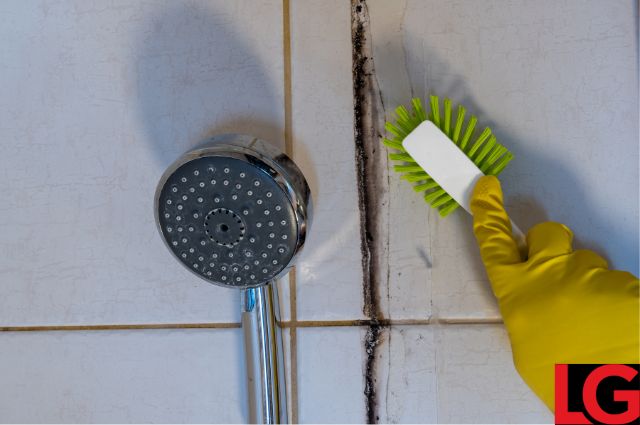
Concrete and Epoxy Floors
These tough surfaces are degreased, scrubbed, and pressure washed if necessary. Any stains from oil or chemicals are treated with specialized cleaners.
Walls and Ceilings
Walls are washed from top to bottom, removing all dust, cobwebs, and marks. This includes:
- Spot cleaning any stains or scuff marks
- Dusting baseboards and crown moulding
- Wiping down all light switches and electrical outlets
Ceilings aren’t forgotten either. Cleaners remove cobwebs, dust light fixtures, and clean ceiling fans. In some cases, acoustic ceiling tiles may need to be vacuumed or replaced if they’re stained or damaged.
Window and Glass Cleaning
Windows are a major focal point in commercial spaces. A thorough cleaning includes:
- Washing both interior and exterior surfaces of all windows
- Cleaning window tracks and sills
- Scrubbing down window frames
- Removing any stickers or adhesive residue
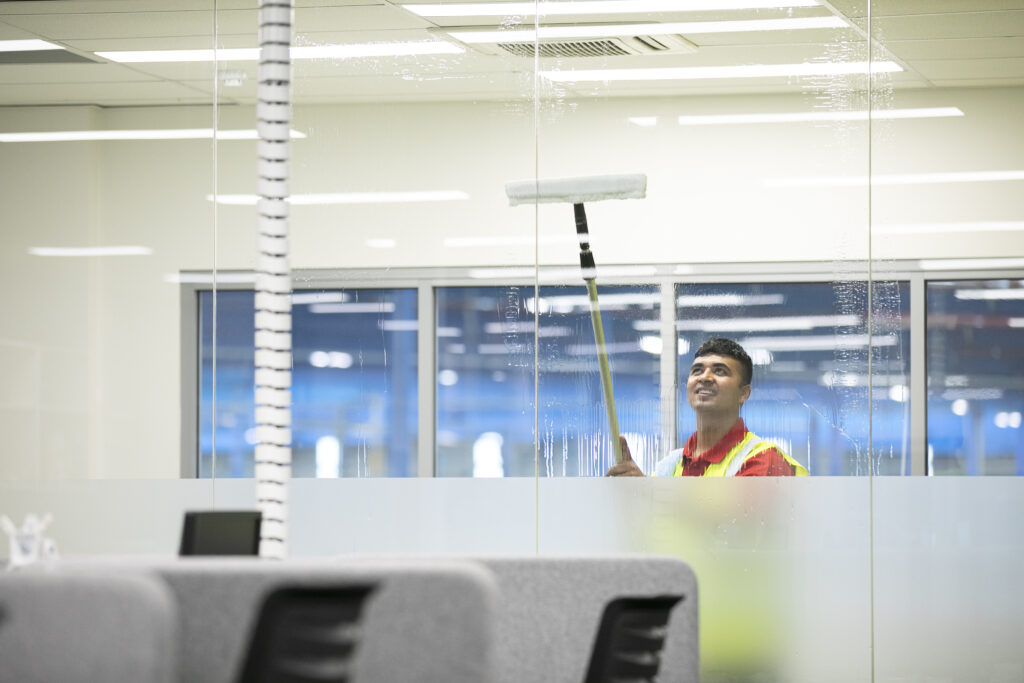
Don’t forget about other glass surfaces:
- Interior glass partitions
- Mirrors in bathrooms and other areas
- Glass doors and display cases
All glass surfaces are cleaned until they’re streak-free and sparkling.
Fixtures and Fittings
Light Fixtures
Light fixtures collect a surprising amount of dust and dead insects. Cleaning includes:
- Removing light covers and washing them thoroughly
- Dusting bulbs and replacing any that are burnt out
- Cleaning recessed lighting and track lighting systems
Air Vents and HVAC Systems
Clean air vents are crucial for maintaining good indoor air quality. This process involves:
- Removing vent covers and washing them
- Vacuuming inside ductwork as far as possible
- Wiping down exterior surfaces of HVAC units
Door Hardware and Other Fixtures
Often overlooked, these items need attention too:
- Cleaning and polishing door handles and push plates
- Wiping down light switches and electrical outlets
- Dusting and cleaning fire extinguisher cases
High-Traffic Areas
Restrooms
Commercial bathrooms need extra attention to meet health and sanitation standards:
- Deep cleaning and sanitising all surfaces, including toilets, urinals, sinks, and countertops
- Scrubbing tile floors and grout lines
- Cleaning and polishing all mirrors and chrome fixtures
- Descaling toilets and urinals to remove mineral build-up
- Sanitising all door handles, stall locks, and other high-touch surfaces
- Restocking paper products and soap dispensers
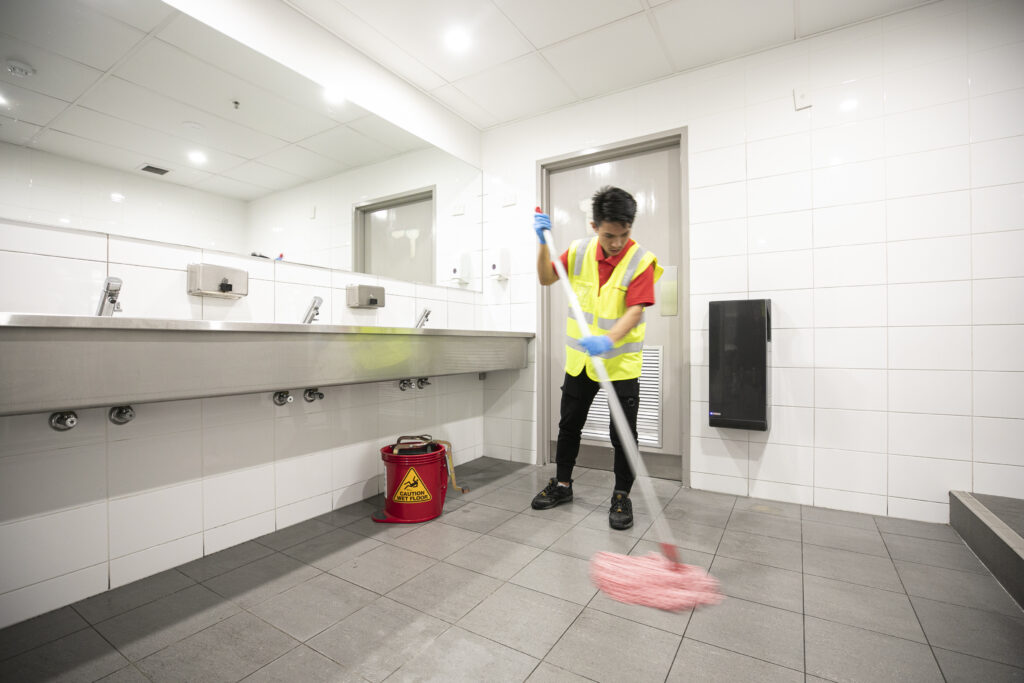
Kitchens and Break Rooms
These areas often have built-up grime from daily use:
- Deep cleaning all appliances, including refrigerators, microwaves, and dishwashers
- Degreasing stovetops and range hoods
- Cleaning inside and behind all appliances
- Sanitising countertops and backsplashes
- Cleaning out and sanitising trash bins
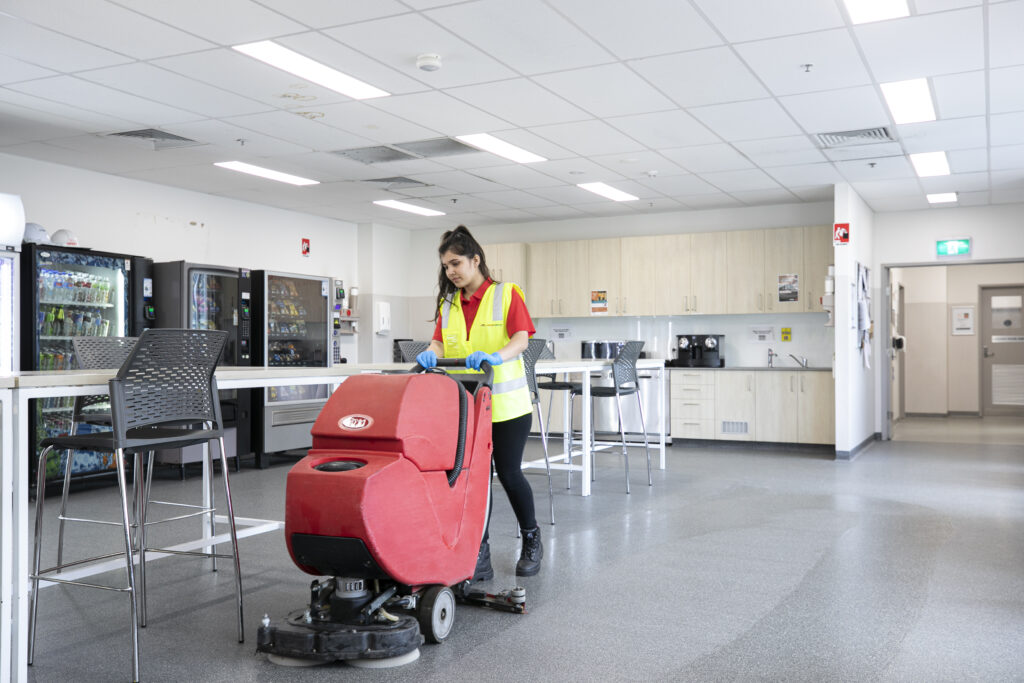
Industry-Specific Cleaning
Different types of businesses have unique cleaning requirements:
Medical Facilities
Medical offices and clinics need a higher level of sanitization:
- Using hospital-grade disinfectants on all surfaces
- Properly disposing of any medical waste
- Cleaning and sanitising examination tables and equipment
- Paying extra attention to waiting areas and reception desks
Industrial and Manufacturing Spaces
These environments often have heavy-duty cleaning needs:
- Degreasing and cleaning heavy machinery
- Addressing chemical spills or residues
- Cleaning high ceilings and hard-to-reach areas
- Power washing floors and walls in production areas
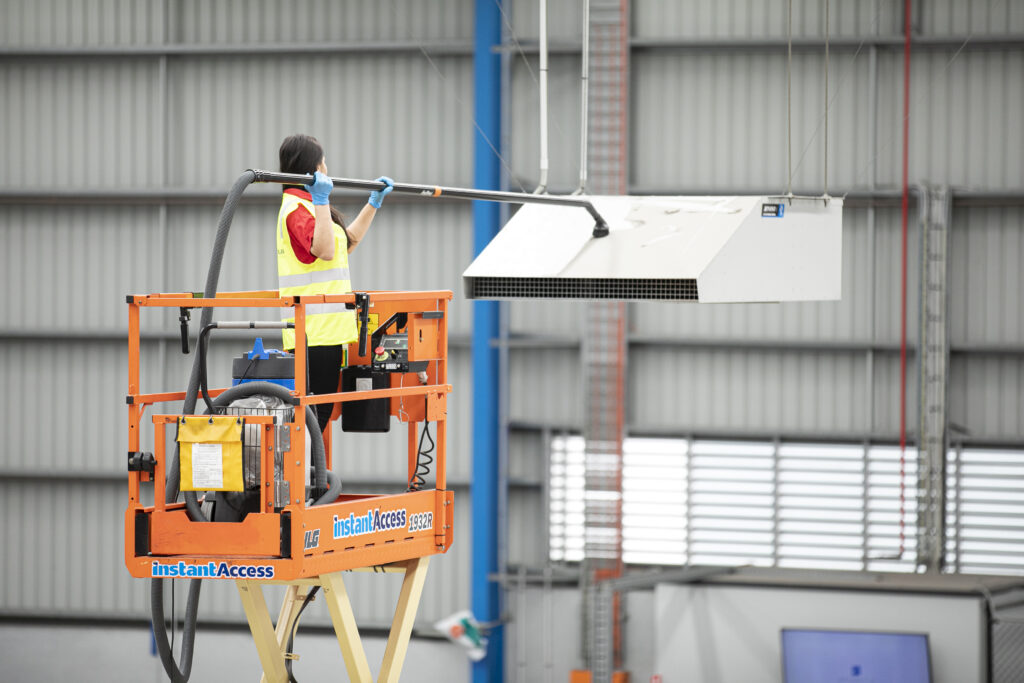
Retail Spaces
Retail environments focus on creating a pristine customer-facing area:
- Cleaning and polishing display cases and shelving units
- Deep cleaning dressing rooms and mirrors
- Sanitising point-of-sale areas and cash registers
- Cleaning and buffing sales floor areas
Odour Elimination
Removing lingering odours is a crucial part of the cleaning process:
- Using professional-grade deodorizers to neutralise smells
- Addressing specific odour sources (e.g., mildew, smoke, food odours)
- Cleaning or replacing air filters in HVAC systems
- Using ozone generators in severe cases (after hours and with proper safety precautions)
Exterior Cleaning
The outside of the property shouldn’t be neglected:
- Sweeping and cleaning entryways and sidewalks
- Pressure washing exterior walls and signage
- Cleaning exterior windows and frames
- Addressing any landscaping issues (e.g., trimming overgrown plants, removing weeds)
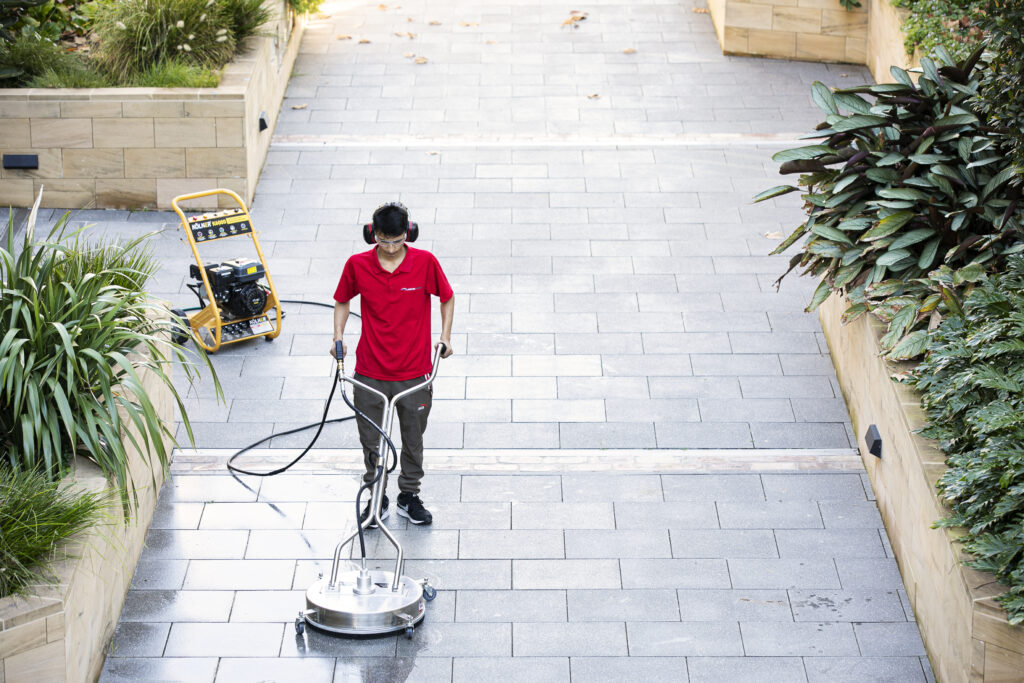
Waste Removal
Part of the cleaning process involves removing all waste and unwanted items:
- Properly disposing of all trash and recyclables
- Removing any furniture or equipment left behind
- Clearing out storage areas and closets
- Ensuring all personal items are removed from the premises
Specialised Cleaning Services
Depending on the property, extra services might be necessary:
High-Rise Window Cleaning
For multi-story buildings, professional window cleaners use specialized equipment to clean exterior windows safely.
Parking Garage Cleaning
This involves sweeping, pressure washing, and removing oil stains from parking areas.
Gym and Pool Cleaning
For apartment buildings with a pool and gym, these cannot be overlooked.
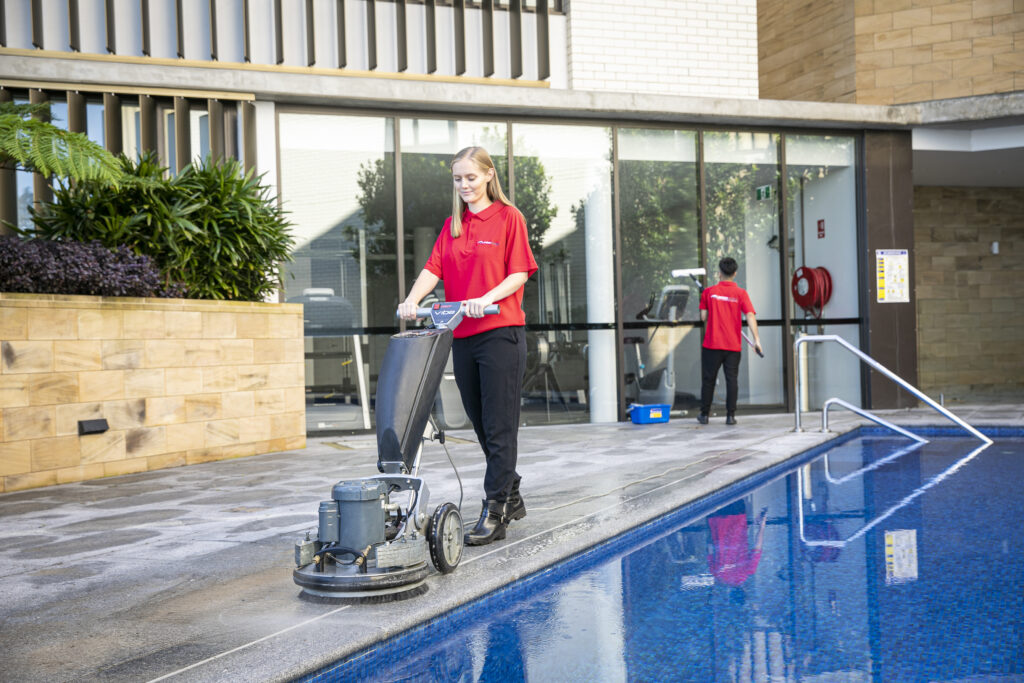
Documentation and Final Inspection
The cleaning process isn’t complete without proper documentation:
- Taking before and after photos of all areas
- Completing a detailed checklist of all tasks performed
- Conducting a final walkthrough with the property manager or landlord
- Addressing any areas of concern immediately
Common Challenges and Solutions
Time Constraints
Challenge: There’s often a tight window between lease end and new tenant move-in.
Solution: Proper planning and scheduling are crucial. I always recommend starting the cleaning process as early as possible, even before all items are moved out.
This might mean cleaning in phases or working around movers.
Hidden Damage
Challenge: Cleaning often reveals previously hidden damage or wear.
Solution: Document all issues discovered during cleaning. Communicate with the landlord immediately about any significant problems.
Be prepared to address minor repairs if they’re within the scope of your lease agreement.
Coordination with Move-Out
Challenge: Balancing cleaning with the logistics of moving out can be tricky.
Solution: Create a detailed schedule that coordinates cleaning with the move-out process. Clean areas as they’re emptied, and use protective coverings to prevent re-soiling of cleaned areas.
Stubborn Stains or Damage
Challenge: Some stains or damage may seem impossible to remove.
Solution: Professional cleaners have access to specialized products and techniques. For truly stubborn issues, it may be necessary to ask with the landlord about reasonable wear and tear expectations.
Hiring Professional Cleaners vs. DIY
While it might be tempting to handle the cleaning in-house, there are several advantages to hiring professionals:
- Expertise in handling different surfaces and materials
- Access to industrial-grade equipment and cleaning products
- Efficiency in completing the job quickly and thoroughly
- Reduced risk of damage to property because of improper cleaning techniques
- Professional documentation and reporting for lease requirements
Preparing for an End of Lease Commercial Clean
To ensure a smooth cleaning process:
- Start planning early, ideally several weeks before the lease end date
- Create a comprehensive inventory of all areas needing cleaning
- Remove all personal items and furniture before deep cleaning begins
- Repair any minor damages (e.g., small holes in walls, loose fixtures)
- Communicate clearly with your cleaning team about expectations and any specific lease requirements
Frequently Asked Questions
What is typically included in an end of lease commercial clean?
An end of lease commercial clean typically includes deep cleaning of all surfaces, floors, windows, and fixtures. It covers everything from carpets and walls to light fixtures and air vents. The goal is to return the property to it’s original condition, minus normal wear and tear.
How long does an end of lease commercial clean take?
The duration depends on the size and condition of the property. For a small office space, it might take a day or two. Larger commercial properties could need several days to a week for a thorough clean.
Do I need to hire professional cleaners for an end of lease clean?
While not always required, professional cleaners are highly recommended. They have the expertise, equipment, and products to ensure a thorough clean that meets lease requirements.
What should I do if the cleaning reveals hidden damage?
Document the damage with photos and notify your landlord immediately. Discuss whether the damage falls under normal wear and tear or if repairs are needed.
Can I do the end of lease cleaning myself to save money?
While possible, DIY cleaning often falls short of professional standards. You risk losing your security deposit if the cleaning doesn’t meet the landlord’s expectations.
What cleaning products are used in commercial end of lease cleans?
Professional cleaners use a range of industrial-strength products, including degreasers, disinfectants, carpet shampoos, and specialised cleaners for different surfaces.
How do I prepare for an end of lease commercial clean?
Remove all personal items and furniture, perform any minor repairs, and create a detailed cleaning checklist. Communicate clearly with your cleaning team about any specific requirements or problem areas.
What if I’m not satisfied with the cleaning results?
Reputable cleaning companies often offer a satisfaction guarantee. If you’re not happy with the results, contact them immediately to address any issues before your final inspection.
Are there any areas that are commonly overlooked in end of lease commercial cleans?
Yes, areas like light fixtures, baseboards, window tracks, and behind appliances are often overlooked. A professional cleaning team will ensure these areas are not forgotten.
Key Takeaways
- A thorough end of lease commercial clean covers every aspect of the property, from floors to ceilings.
- Different types of commercial spaces have unique cleaning requirements that need to be addressed.
- Professional cleaners bring expertise, equipment, and efficiency to ensure the job meets lease standards.
- Proper planning and coordination are crucial for a successful end of lease clean.
- Documentation, including before and after photos, is essential for protecting your security deposit.
- Addressing common challenges like time constraints and hidden damage requires proactive communication and problem-solving.
For the experts in end of lease cleaning for industrial, commercial or residential – contact Landon Group today.
Keep Your Facility at Its Best
Looking to stay ahead in maintaining exceptional facilities? Explore these related resources:
–9 Signs of an Excellent Commercial Cleaner – Spot the traits that separate the good from the great.
–Factory and Warehouse Cleaning Techniques – Learn the secrets to tackling even the toughest industrial cleaning challenges.
–Top Preventative Property Management Actions for Facilities Managers – Discover proactive steps to keep your property in top shape.
These blogs are filled with actionable insights to help you make informed choices and uphold the highest standards for your facility. Dive in today!
